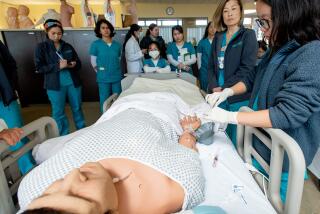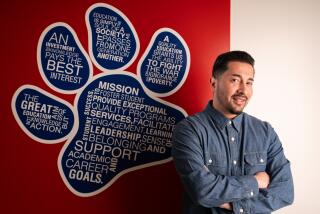CSUCI Invites 1st Students, Fills Staff for Its Stretch Run
When the letter arrived last week, tucked neatly into an ordinary business-sized envelope, Thousand Oaks resident Craig Stankis had no way of knowing his place in history.
There he was, receiving what equaled a written handshake for earning admission to the soon-to-open Cal State Channel Islands campus near Camarillo, without any clue he was among the first students to get in.
A student at Moorpark College, the 41-year-old warehouse worker said all he knew was that the four-year campus provided the perfect opportunity to pursue his dream of becoming a teacher.
Now he has set his sights on another history-making moment: joining the university’s first graduating class in 2004.
“They’ve been saying they were going to build a university out here for years and years,” said Stankis, who grew up less than five miles from the Channel Islands campus. “When the opportunity came, I knew I wanted to go there.”
After more than 30 years of planning and preparation, with heartbreaking setbacks and heart-pounding successes, Ventura County’s first, four-year public university will open Aug. 26 at the former Camarillo State Hospital complex.
Anticipating a $21-million budget for next fiscal year, and having generated nearly $13 million in private support for scholarships and capital projects, the university stands on a threshold.
The start of the year marks the stretch run for the long-awaited campus, the 23rd in the Cal State University system and the first launched since 1995.
And when it formally opens for business, amid ribbon cuttings and spirited speeches, it will mark the culmination of a hard-fought campaign to make higher education more accessible in a region where generations of students have had no choice but to leave if they wanted a state college degree.
“People won’t realize, until it has happened, what a tremendous impact this university will have,” said Carolyn Leavens, a Ventura farmer and business leader who has worked for years to bring a Cal State campus to the county.
Community Opposition Slowed Progress
“I don’t think any of us who signed on at the beginning ever said, ‘This is not going to happen, we might as well give up,’ ” she said. “We signed on for as long as it took.”
On the drawing board since 1969, plans for a local campus had fallen well down on the CSU system’s priority list over the years, as community opposition thwarted one proposal after another and CSU trustees soured on the project for lack of support.
By 1990, when after months of contentious deliberations CSU trustees eliminated from consideration a sweeping hillside bluff near Ventura for the new campus, Ventura County held the distinction of being the largest county in the state without a public, four-year college.
Then came a proposal, floated in 1996 and endorsed a year later by the Cal State governing board, to convert the aging state hospital into a modern-day campus, a move that ultimately resulted in creation of the long-promised university years earlier than anticipated.
Now the launch date is fast approaching and there is still plenty to do.
Admissions officers have received more than 300 applications for the approximately 800 full- and part-time slots that will be available at the campus.
Because admission is restricted this fall to upper-division transfer students--the first freshman class won’t show up until fall 2003--applications from community college students are expected to flood the campus in the next couple of months.
At the same time, the university’s founding faculty members are busy whittling down more than 4,000 applications for 25 teaching positions that must be filled before the university opens. And senior staff members are busy filling up to 70 staff positions.
Then there’s the behind-the-scenes work to be done, from making sure the emerging university stays on pace to earn accreditation by 2006 to figuring out how to operate two campuses--Channel Islands and a satellite campus of Cal State Northridge--on the same site.
The CSUN branch opened at the site in 1999 as a precursor to Cal State Channel Islands. CSUN’s off-campus operation is set to be phased out over the next several years.
“I know what’s expected every week and every month; for me, it’s just the same as shaving each morning or breathing the rest of the day,” said Channel Islands President Richard Rush, whose chief job is to hold it all together as the stretch run comes down to the wire.
“We are right on schedule with everything we’ve done so far,” he said. “We all feel that we are carrying the responsibility of everybody’s hopes and dreams, and the fact of the matter is, we take that very seriously.”
Founding Faculty Works on Curriculum
Opening a university may be serious business, but that doesn’t mean faculty and staff can’t enjoy themselves along the way.
In the faculty conference room, professors were huddled last week around an oval table littered with candy, cookies and soft drinks--quick energy for the monumental tasks at hand.
In coming months, the 13 founding faculty members will put the finishing touches on the university’s curriculum and complete an exhaustive search for additional faculty needed to teach in the fall.
Recruited from universities around the world, the founding faculty has been busy since the summer, planning and drafting the hundreds of Channel Islands courses that will appear in the fall catalog.
Courses will be offered in eight majors: biology, business, environmental science and resource management, English, fine arts, liberal studies, computer science and math. The university also will offer a credential program for aspiring elementary school teachers.
While the catalog will feature many of the standard courses available at any university, there has been an emphasis at Channel Islands on cross-breeding disciplines to create a new strain of courses as innovative as they are functional.
For example, arts professor Jack Reilly has teamed with the English department to offer a course in art history that delves into literature and the Renaissance. And economics professor Dennis Muraoka has been working on a class about the drug industry that combines the chemical aspects with the business side.
Muraoka, who doubles as chairman of the university’s Academic Senate, said this broad-based approach better prepares students to confront problems they may face in the real world.
“Too often, students can develop tunnel vision if they become too focused on their majors and lose sight of other ways of thinking,” he said. “Virtually every one of the programs we’ve developed has extremely interesting connections to other disciplines.”
It is that kind of academic flexibility, the once-in-a-lifetime opportunity to craft a college curriculum on what is largely a blank slate, that has drawn the founding faculty members from as far away as Australia.
And it’s that same opportunity that has generated 4,200 applications for the remaining faculty positions.
That pool has been whittled down to fewer than 250. And of those, about 80 will be invited to the campus next month for interviews. University officials hope to make job offers by mid-April.
“There are university jobs open every day, but starting up a new university, that’s very special,” said Ira Schoenwald, associate vice president for faculty. “The work that these people are doing will have an impact 10 to 15 years from now, maybe longer. You can imagine how exciting that is and why people want to be a part of it.”
On the other side of the sprawling 600-acre campus, a ready-made university dominated by rolling lawns and Spanish-style buildings, a different kind of recruitment is underway.
Recruitment director Sue Saunders has led a team of outreach specialists to schools, conferences and college fairs to whip up excitement among potential students about the developing campus.
She said for the most part she’s finding it to be an easy sell, especially in this region, where people are hungry for news of the Channel Islands campus.
“Everyone has waited so long to have a four-year public institution in Ventura County,” said Saunders, who came to Channel Islands from a similar job at Cal Lutheran University in Thousand Oaks. “I think we’re all starting to feel it. I start to get goose bumps when I think about how this fall we’ll start admitting our first students.”
Richard Rush feels it too.
Even though he’s been through it before, having played a key role in the late 1980s and early 1990s in the development of Cal State San Marcos, Rush remains awed by what he and other university officials are about to accomplish.
Sure, there are budgets to pore over, enrollment targets to worry about. But he said anyone who looks at the effort with a narrow scope is bound to miss the bigger picture.
“This is a millennial endeavor we are engaged in,” he said. “When you put it into that context, it really is kind of awesome.”
FOR b1 FOTO SLUGGED csuci6
More to Read
Sign up for Essential California
The most important California stories and recommendations in your inbox every morning.
You may occasionally receive promotional content from the Los Angeles Times.









